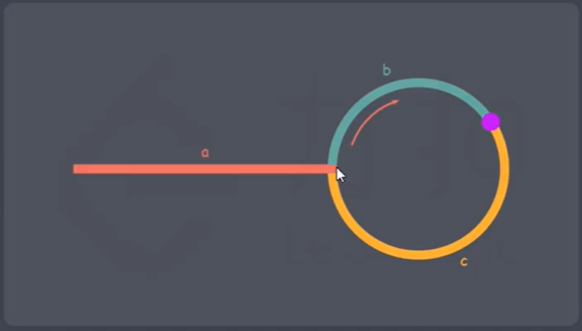什么是链表?
链表是有序的数据结构,链表中的每个部分称为节点。可以首、尾、中间进行数据存取,链表的元素在内存中不必是连续的空间,每个节点通过 next 指针指向下一个节点。

优点
链表的添加和删除不会导致其余元素位移。
缺点
无法根据索引快速定位元素。
数组和链表区别
- 获取、修改元素时,数组效率高
- 添加、删除元素时,链表效率高
- 数组添加、移除会导致后续元素位移,性能开销大
环形链表
指的是链表最后一个节点的 next 指向第一个节点,形成首尾相连的循环结构。
链表环路检测
解题思路:
- 快慢指针法实现
- slow 指针每次移动一位,fast 指针每次移动两位,如果他们相遇则说明链表存在环
- 新指针 ptr 从 head 开始移动,与 slow 相遇的位置即为环的起点
- 由 fast 指针移动距离为 slow 的两倍可得出公式:a + (nb + nc + b) = 2(a + b)
- 变化处理后得到新公式:a = (n - 1)(b + c) + c

实现功能
在 JavaScript 中没有链表,但是可以通过 Ojbect 进行实现链表的所有功能。
节点类:
- value 当前节点值
- next 指向下一个节点
链表类:
- addAtTail 尾部添加节点
- addAtHead 头部添加节点
- addAtIndex () 指定位置添加节点
- get 获取节点
- removeAtIndex () 删除指定节点
应用场景
leetcode 两数相加 。
案例
通过 Object 实现
const a = { val: 'a' };const b = { val: 'b' };const c = { val: 'c' };const d = { val: 'd' };a.next = b;b.next = c;c.next = d;// 遍历链表let p = a;while (p) {console.log(p.val);p = p.next;}// 插入const e = { val: 'e' };c.next = e;e.next = d;// 删除c.next = d;
通过类模拟实现
/*** 节点类*/class Node {constructor(value) {this.value = value;this.next = null;}}/*** 链表类*/class Link {constructor() {this.head = null;this.count = 0;}/*** 尾部添加节点*/addAtTail(item) {if (this.count === 0) {this.head = new Node(item);this.count++;return this.head;}let endNode = this.head;while (endNode.next) {endNode = endNode.next;}endNode.next = new Node(item);this.count++;return item;}/*** 头部添加节点*/addAtHead(item) {if (this.head) {const oldHead = this.head;this.head = new Node(item);this.head.next = oldHead;} else {this.head = new Node(item);}this.count++;return item;}/*** 指定位置添加节点*/addAtIndex(index, item) {if (this.isInvalidIndex(index) || !this.head) {return -1;}if (index === 0) {this.addAtHead(item);return item;}let prev = this.head;while (index > 0) {index--;}const next = prev.next;const cur = new Node(item);prev.next = cur;cur.next = next;this.count++;return item;}/*** 获取节点*/get(index) {if (this.isInvalidIndex(index) || !this.head) {return -1;}let cur = this.head;while (index > 0) {cur = cur.next;index--;}return cur;}/*** 删除指定节点*/removeAtIndex(index) {if (this.isInvalidIndex(index) || !this.head) {return -1;}if (index === 0) {const oldHead = this.head;this.head = this.head.next;this.count--;return oldHead;}let prev = this.head;while (index - 1 > 0) {prev = prev.next;index--;}const cur = prev.next;prev.next = cur.next;this.count--;return cur;}/*** 判断index是否为空,是否超出数据长度大小*/isInvalidIndex(index) {if (index === '' || index === null || index === undefined || index < 0 || index > this.count - 1) {return true;}return false;}}const link = new Link();link.addAtTail('a');link.addAtTail('b');link.addAtTail('c');

